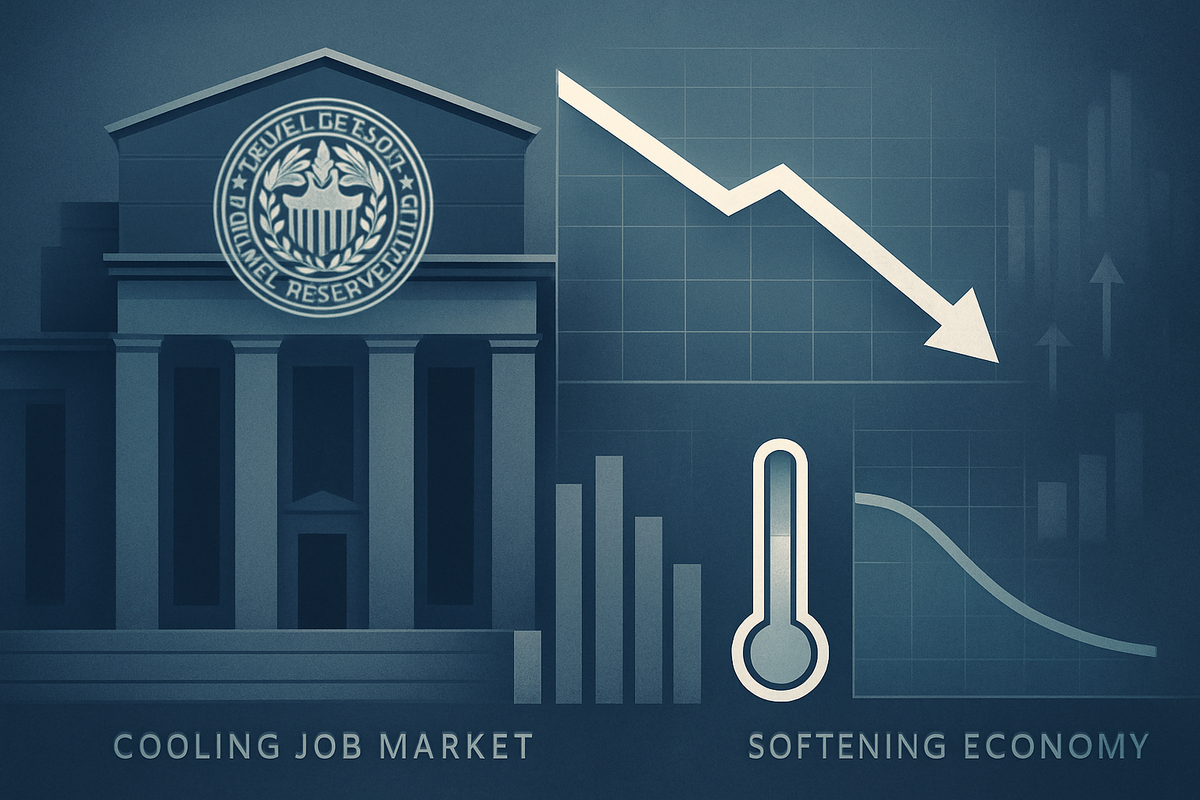
The financial world is holding its breath as the Federal Reserve convenes its Federal Open Market Committee (FOMC) meeting on October 28-29, 2025. Market participants and economists alike are anticipating a highly probable second consecutive interest rate cut, a move that signals the central bank's growing concern over a softening U.S. economy, a noticeably cooling job market, and persistent, albeit moderating, inflation. This pivot towards monetary easing is expected to lower borrowing costs, potentially stimulating economic activity, but also highlights the delicate balancing act the Fed faces in navigating a complex economic landscape.
The impending decision, which would likely see a 25-basis-point reduction in the federal funds rate, is a critical juncture for both Main Street and Wall Street. It reflects a significant shift from the aggressive tightening cycle of previous years, marking a new phase where the Fed prioritizes supporting economic growth in the face of decelerating employment and output. The implications are far-reaching, from influencing consumer spending and corporate investment to shaping the trajectory of equity and bond markets in the coming months.
A Second Consecutive Cut: The Fed's Response to Economic Headwinds
The Federal Reserve is widely expected to implement a 25-basis-point (0.25%) interest rate cut at its October 28-29, 2025 meeting, following a similar reduction in September. This would bring the federal funds rate target range to 3.75%-4.00% from its current 4.00%-4.25%. Market probabilities, as indicated by CME Group FedWatch data and bond futures, hover around 98-99% for this reduction, with economists from BofA Securities (NYSE: BAC) and Barclays (LON: BARC) among those forecasting the cut.
This strategic shift is primarily driven by three interconnected factors. Firstly, the cooling job market has become increasingly evident. The U.S. economy added 911,000 fewer jobs through March 2025 than initially reported, a record downward revision. Average monthly nonfarm payroll gains plummeted to just 30,000 in the three months leading up to August 2025, a sharp decline from 168,000 in 2024. August 2025 saw a meager 22,000 jobs added, and June even registered a loss of 13,000 positions, the first negative report since December 2020. The unemployment rate climbed to 4.3% in August, its highest since 2021, with youth unemployment (16-24) jumping to 10.5%. Private sector payrolls, as reported by ADP, decreased by 32,000 in September 2025, the largest decline in over two years.
Secondly, a softening economy is also pushing the Fed towards easing. While Q2 2025 GDP growth was robust at 3.8% annualized, Q3 forecasts are more subdued, ranging from 2.1% to 3.3% according to Federal Reserve Bank nowcasting models, and even lower at 0.9% to 1.3% from professional forecaster surveys. The consensus for Q3 GDP growth hovers around 2.0%. Consumer spending, a key economic driver, is projected to slow in 2026 after a healthy 2.1% rise in 2025. While business investment remains strong, particularly in AI-related ventures, overall real GDP is expected to decelerate to 1.4% in 2026 from an anticipated 1.8% in 2025.
Finally, ongoing inflation concerns, while still present, are showing signs of moderation. The annual Consumer Price Index (CPI) rose to 3% in September 2025, up from 2.9% in August, but notably came in below forecasts of 3.1%. More importantly, annual core inflation (excluding volatile food and energy prices) slowed to 3% in September from 3.1%, providing some relief. The Fed's preferred inflation gauge, the Personal Consumption Expenditures (PCE) deflator, was at 2.6% year-over-year in July, with core PCE at 3.1%. Forecasts for Q3 2025 PCE inflation are around 2.9%, a decrease from earlier estimates. Federal Reserve Chair Jerome Powell has consistently emphasized the need to balance the risks of a softer employment picture with above-target inflation to justify a less restrictive monetary policy.
Companies Poised to Win or Lose from Lower Rates
A Federal Reserve interest rate cut creates a distinct ripple effect across various sectors of the public market, favoring some companies while potentially challenging others. The primary mechanism is the alteration of borrowing costs for both businesses and consumers, which influences investment, spending, and profitability.
Potential Winners:
Companies with significant debt, particularly those with variable-rate loans, stand to gain considerably. Lower interest rates directly reduce their interest expenses, boosting cash flow and profitability. Examples include capital-intensive firms like Six Flags Entertainment (NYSE: FUN), which carries substantial annual interest expenses, and telecommunications giants such as Verizon (NYSE: VZ), which can refinance debt accumulated from extensive infrastructure buildouts (e.g., 5G) at more favorable rates. Leveraged finance issuers with floating-rate debt structures will also see immediate relief.
Growth-oriented companies, especially in the technology sector, are also strong beneficiaries. These firms often rely on borrowing to fund innovation, research and development, and expansion. Cheaper capital allows them to invest more aggressively, and in valuation models, lower discount rates increase the present value of their future earnings, making them more attractive to investors. Mid-cap tech stocks with high debt balances are particularly well-positioned.
Interest-rate-sensitive sectors like real estate, homebuilding, and automobiles are set for a boost. Lower mortgage rates and auto loan rates make large purchases more affordable for consumers, stimulating demand. Homebuilders such as PulteGroup (NYSE: PHM), D.R. Horton (NYSE: DHI), and Lennar (NYSE: LEN) directly benefit from increased housing demand, as do building material suppliers like Builders FirstSource (NYSE: BLDR). Automobile manufacturers like General Motors (NYSE: GM) could see a surge in sales. Real Estate Investment Trusts (REITs) also benefit from lower borrowing costs, which support property values and improve the economics of property acquisitions.
Consumer discretionary companies, including retailers like Target (NYSE: TGT) and Walmart (NYSE: WMT), as well as travel and entertainment providers like Carnival Corporation (NYSE: CCL), could see increased spending as consumers' disposable income rises due to lower debt servicing costs on credit cards and personal loans. PayPal (NASDAQ: PYPL) could benefit from increased consumer spending and business investment, driving higher payment volumes.
The utilities sector, often considered defensive, also finds favor. As bond yields fall, the stable dividend payments of utility stocks become relatively more attractive to income investors, driving demand for companies like NextEra Energy (NYSE: NEE). Additionally, utilities often have high capital expenditures, so lower rates reduce their borrowing costs.
Potential Losers:
The most directly impacted sector facing potential headwinds is banks and financial institutions. A primary concern for banks is the compression of their Net Interest Margin (NIM) – the difference between interest earned on loans and interest paid on deposits. When rates fall, the interest banks earn on assets typically declines faster than the interest they pay on liabilities, especially in a low-rate environment. This can reduce overall profitability. While some institutions like Synchrony Financial (NYSE: SYF) might see benefits if their interest expenses decline more significantly, and increased loan demand could partially offset margin compression for others like Comerica (NYSE: CMA), the general trend for banks is often reduced NIM in a falling rate environment.
Companies holding substantial cash reserves may also see a decrease in their interest income, impacting their overall profitability, although this effect is typically less severe than for banks. While generally stable, some defensive sectors, like certain consumer staples companies, might not see the same relative upside as growth sectors, as their consistent dividend yields become less competitive compared to the potential appreciation in other parts of the market during an easing cycle.
Wider Significance and Broader Market Implications
The Federal Reserve's anticipated rate cut extends far beyond immediate market reactions, signaling a significant shift in monetary policy that will reverberate throughout the global economy. This move firmly plants the U.S. central bank in an easing cycle, a stark contrast to the aggressive tightening witnessed in previous years. This pivot reflects a broader industry trend among global central banks, many of whom are also grappling with slowing growth and moderating inflation, potentially leading to synchronized easing efforts worldwide. Such a trend could ease global financial conditions, stimulate cross-border investment, and potentially devalue the U.S. dollar, making American exports more competitive.
The ripple effects on competitors and partners will be profound. For businesses, lower borrowing costs encourage capital expenditure, potentially spurring innovation and expansion. This could intensify competition in sectors where access to affordable credit is a key differentiator. Partners across supply chains may also see increased demand as consumer and business spending picks up. However, a weaker dollar could also increase the cost of imported goods and raw materials for some companies.
Regulatory and policy implications are also at play. The research indicates that market participants will be keenly watching for cues on the future path of interest rates and, crucially, the potential end of the quantitative tightening (QT) program, which involves the Fed reducing its balance sheet. An early end to QT would inject more liquidity into the financial system, further supporting asset prices and potentially signaling a more aggressive stance towards monetary easing. This could also influence future regulatory discussions around financial stability in a lower-rate environment.
Historically, periods of Fed rate cuts have often followed periods of economic stress or significant tightening. While each cycle is unique, comparisons can be drawn to easing cycles during periods of slowing growth or emerging recessionary concerns. For instance, the rate cuts of 2019, which aimed to provide "insurance" against global slowdowns, or even earlier easing cycles during more pronounced economic downturns, offer precedents for how markets and the economy might respond. However, the current environment is unique due to the specific combination of a robust, albeit cooling, labor market, persistent yet moderating inflation, and strong business investment in areas like AI. The Fed's challenge is to achieve a "soft landing" – bringing inflation down without triggering a severe recession, a feat that has historically been difficult to achieve.
What Comes Next: Navigating the Easing Cycle
Looking ahead, the Federal Reserve's October rate cut is unlikely to be an isolated event. Short-term possibilities include further rate reductions, with many analysts foreseeing an additional quarter-point cut in December 2025, bringing the total reductions for the latter half of the year to 0.75%. This trajectory suggests a sustained period of monetary easing designed to nurture economic growth and stabilize the labor market. In the long term, this could pave the way for a more robust economic recovery in 2026, provided inflation continues its downward trend without reigniting.
For businesses, potential strategic pivots or adaptations are crucial. Companies that have diligently managed their debt during the high-rate environment may now find opportunities to refinance at lower costs, freeing up capital for expansion, research and development, or share buybacks. Those reliant on consumer spending or capital-intensive projects may see renewed demand and investment opportunities. Conversely, businesses that thrived on higher interest income or those with less flexible financial structures may need to adapt to a lower-yield environment.
Market opportunities and challenges will undoubtedly emerge. Investors may shift from defensive, income-generating assets like bonds towards growth-oriented equities, particularly in sectors that benefit most from cheaper capital and increased consumer spending, such as technology, real estate, and consumer discretionary. However, challenges persist, including the risk of a potential economic downturn if the rate cuts are insufficient or if underlying economic weaknesses are more profound than currently perceived. Geopolitical tensions and unforeseen global events also remain significant wildcards.
Potential scenarios and outcomes range from a successful "soft landing" where inflation returns to target and growth stabilizes without a recession, to a more challenging environment if the economy continues to decelerate or if inflation proves stickier than anticipated. The Fed's communication in the post-meeting press conference will be vital in shaping market expectations and guiding investor behavior, offering clues about the central bank's confidence in the economic outlook and its willingness to continue easing.
Comprehensive Wrap-Up: A Pivotal Moment for the Market
The Federal Reserve's highly anticipated interest rate decision at its October 28-29, 2025 meeting marks a pivotal moment, cementing the central bank's shift towards an easing monetary policy. The strong likelihood of another 25-basis-point rate cut is a direct response to a cooling job market, signs of a softening economy, and moderating, though still elevated, inflation concerns. Key takeaways include the Fed's proactive stance in supporting economic activity, the profound impact on borrowing costs, and the differentiated effects on various public companies and sectors.
Moving forward, the market is expected to continue pricing in further rate cuts, with December already on the radar for many analysts. This environment will likely favor growth stocks, highly leveraged companies, and interest-rate-sensitive sectors like real estate and autos, while potentially challenging banks and other financial institutions that face net interest margin compression. The broader significance lies in this shift's potential to influence global monetary policy, encourage business investment, and reshape consumer spending patterns.
Investors should closely watch Federal Reserve Chair Jerome Powell's post-meeting press conference for forward guidance on the pace of future rate cuts and any indications regarding the conclusion of quantitative tightening. Key economic data releases, particularly on inflation and employment, will continue to be critical in shaping the Fed's decisions in the coming months. The success of this easing cycle in achieving a "soft landing" for the U.S. economy remains the ultimate test, and its outcome will have a lasting impact on financial markets and the broader economic landscape.
This content is intended for informational purposes only and is not financial advice








